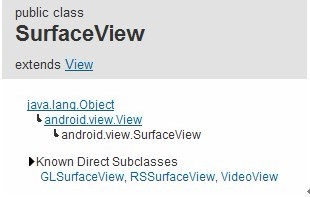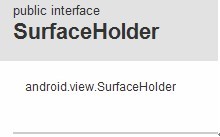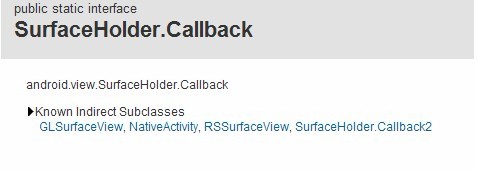使用mediaplayer + surfaceview来播放视频
2012-07-21 12:05
483 查看
转自:http://blog.csdn.net/jiahui524/article/details/7108358
步骤:
mediaPlayer+ surfaceView 例子的步骤:
1,创建一个MediaPlayer,并创建三个按钮
2, 创建surfaceView,并设置surfaceView的getHolder.setType和getHolder.addCallback()
3,在addCallback的三个函数中,这里是如果在播放中建立的,则把positon=0 ,然后重新开始。
4,在按钮中设置mediaplayer的播放,大概是:
mediaPlayer.reset();
mediaPlayer.setAudioStreamType(AudioManager.STREAM_MUSIC);
//设置需要播放的视频
mediaPlayer.setDataSource("/mnt/sdcard/vid320X240.3gp");
//把视频画面输出到SurfaceView
mediaPlayer.setDisplay(surfaceView.getHolder()); ///关键 的地方!!!!!!
mediaPlayer.prepare();
//播放
mediaPlayer.start();
xml源代码:(注意需要三个png格式的图片,更改名字为play.png pause.png stop.png)
java 代码:
注:
MediaPlayer主要用于播放音频,它是没有提供输出图像的输出界面,这时我们就用到了SurfaceView控件,将它与MediaPlayer结合起来,就能达到了视频的输出了。首先来了SurfaceView这个控件类
SurfaceView类

构造方法
常用方法
SurfaceHolder

它是一个接口,用于管理SurfaceView。里面有两个常用的内部接口SurfaceHolder.Callback,SurfaceHolder.Callback2而Callback2是实现于Callback的
常用方法
SurfaceHolder.CallBack

在Callback里有三个抽象方法
如何理解这几个类或者接口之间的关系?
这样理解:
SurfaceView它用于显示,SurfaceHolder就是用于用来管理这个显示的SurfaceView对象的,但在SurfaceHolder是怎么样去管理这个对象的呢?这就用到了SurfceHolder.addCallback()方法添加一个SurfaceHolder接口的内部接口的三个抽象方法用于管理或者说是用于监听SurfaceView。这样就达到了管理SurfaceView的目的。
mediaPlayer 的方法是:
步骤:
mediaPlayer+ surfaceView 例子的步骤:
1,创建一个MediaPlayer,并创建三个按钮
2, 创建surfaceView,并设置surfaceView的getHolder.setType和getHolder.addCallback()
3,在addCallback的三个函数中,这里是如果在播放中建立的,则把positon=0 ,然后重新开始。
4,在按钮中设置mediaplayer的播放,大概是:
mediaPlayer.reset();
mediaPlayer.setAudioStreamType(AudioManager.STREAM_MUSIC);
//设置需要播放的视频
mediaPlayer.setDataSource("/mnt/sdcard/vid320X240.3gp");
//把视频画面输出到SurfaceView
mediaPlayer.setDisplay(surfaceView.getHolder()); ///关键 的地方!!!!!!
mediaPlayer.prepare();
//播放
mediaPlayer.start();
xml源代码:(注意需要三个png格式的图片,更改名字为play.png pause.png stop.png)
<?xml version="1.0" encoding="utf-8"?>
<LinearLayout xmlns:android="http://schemas.android.com/apk/res/android"
android:layout_width="fill_parent"
android:layout_height="fill_parent"
android:orientation="vertical" >
<SurfaceView
android:id="@+id/surfaceView"
android:layout_width="fill_parent"
android:layout_height="360px" />
<LinearLayout
android:layout_width="fill_parent"
android:layout_height="wrap_content"
android:gravity="center_horizontal"
android:orientation="horizontal" >
<ImageButton
android:id="@+id/btnplay"
android:layout_width="wrap_content"
android:layout_height="wrap_content"
android:src="@drawable/play" />
<ImageButton
android:id="@+id/btnpause"
android:layout_width="wrap_content"
android:layout_height="wrap_content"
android:src="@drawable/pause" />
<ImageButton
android:id="@+id/btnstop"
android:layout_width="wrap_content"
android:layout_height="wrap_content"
android:src="@drawable/stop" />
</LinearLayout>
</LinearLayout>java 代码:
package com.example.tstmediaplaycontroller2;
/*
import android.os.Bundle;
import android.app.Activity;
import android.view.Menu;
import android.view.MenuItem;
import android.support.v4.app.NavUtils;
public class MainActivity extends Activity {
@Override
public void onCreate(Bundle savedInstanceState) {
super.onCreate(savedInstanceState);
setContentView(R.layout.activity_main);
}
@Override
public boolean onCreateOptionsMenu(Menu menu) {
getMenuInflater().inflate(R.menu.activity_main, menu);
return true;
}
}*/
import android.app.Activity;
import android.media.AudioManager;
import android.media.MediaPlayer;
import android.os.Bundle;
import android.view.SurfaceHolder;
import android.view.SurfaceHolder.Callback;
import android.view.SurfaceView;
import android.view.View;
import android.view.View.OnClickListener;
import android.widget.Button;
import android.widget.ImageButton;
import android.widget.Toast;
public class MainActivity extends Activity implements OnClickListener{
ImageButton btnplay, btnstop, btnpause;
SurfaceView surfaceView;
MediaPlayer mediaPlayer;
int position;
public void onCreate(Bundle savedInstanceState) {
super.onCreate(savedInstanceState);
setContentView(R.layout.activity_main);
btnplay=(ImageButton)this.findViewById(R.id.btnplay);
btnstop=(ImageButton)this.findViewById(R.id.btnstop);
btnpause=(ImageButton)this.findViewById(R.id.btnpause);
btnstop.setOnClickListener(this);
btnplay.setOnClickListener(this);
btnpause.setOnClickListener(this);
mediaPlayer=new MediaPlayer();
surfaceView=(SurfaceView) this.findViewById(R.id.surfaceView);
//设置SurfaceView自己不管理的缓冲区
surfaceView.getHolder().setType(SurfaceHolder.SURFACE_TYPE_PUSH_BUFFERS);
surfaceView.getHolder().addCallback(new Callback() {
@Override
public void surfaceDestroyed(SurfaceHolder holder) {
}
@Override
public void surfaceCreated(SurfaceHolder holder) {
if (position>0) {
try {
//开始播放
play();
//并直接从指定位置开始播放
mediaPlayer.seekTo(position);
position=0;
} catch (Exception e) {
// TODO: handle exception
}
}
System.out.println("surface create .............xxxxxxxxxxxxxxxx");
}
@Override
public void surfaceChanged(SurfaceHolder holder, int format, int width,
int height) {
}
});
}
@Override
public void onClick(View v)
{
switch (v.getId()) {
case R.id.btnplay:
play();
break;
case R.id.btnpause:
if (mediaPlayer.isPlaying())
{
mediaPlayer.pause();
}
else
{
mediaPlayer.start();
}
break;
case R.id.btnstop:
if (mediaPlayer.isPlaying()) {
mediaPlayer.stop();
}
break;
default:
break;
}
}
@Override
protected void onPause() {
//先判断是否正在播放
if (mediaPlayer.isPlaying()) {
//如果正在播放我们就先保存这个播放位置
position=mediaPlayer.getCurrentPosition()
;
mediaPlayer.stop();
}
super.onPause();
}
private void play() {
try {
mediaPlayer.reset();
mediaPlayer.setAudioStreamType(AudioManager.STREAM_MUSIC);
//设置需要播放的视频
mediaPlayer.setDataSource("/mnt/sdcard/vid320X240.3gp");
//把视频画面输出到SurfaceView
mediaPlayer.setDisplay(surfaceView.getHolder());
mediaPlayer.prepare();
//播放
mediaPlayer.start();
Toast.makeText(this, "开始播放!", Toast.LENGTH_LONG).show();
} catch (Exception e) {
// TODO: handle exception
}
}
}注:
MediaPlayer主要用于播放音频,它是没有提供输出图像的输出界面,这时我们就用到了SurfaceView控件,将它与MediaPlayer结合起来,就能达到了视频的输出了。首先来了SurfaceView这个控件类
SurfaceView类

构造方法
| 方法名称 | 描述 |
| public SurfaceView(Context context) | 通过Context创建SurfaceView对象 |
| public SurfaceView(Context context, AttributeSet attrs) | 通过Context对象和AttributeSet创建SurfaceView对象 |
| public SurfaceView(Context context, AttributeSet attrs, int defStyle) | 通过Context对象和AttributeSet创建并可以指定样式,SurfaceView对象 |
| 方法名称 | 描述 |
| public SurfaceHolder getHolder () | 得到SurfaceHolder对象用于管理SurfaceView |
| public void setVisibility (int visibility) | 设置是否可见,其值可以是VISIBLE, INVISIBLE, GONE. |

它是一个接口,用于管理SurfaceView。里面有两个常用的内部接口SurfaceHolder.Callback,SurfaceHolder.Callback2而Callback2是实现于Callback的
常用方法
| 方法名称 | 描述 |
| public abstract void addCallback (SurfaceHolder.Callback callback) | 添加一个Callback对象监听SurfaceView的变化 |
| public abstract void removeCallback (SurfaceHolder.Callback callback) | 移除Callback |
| public abstract void setType (int type) | 设置SurfaceView的控制方式 |
| public abstract Canvas lockCanvas () | 锁定整个SurfaceView对象,获取该Surface上的Canvas |
| public abstract Canvas lockCanvas (Rect dirty) | 锁定SurfaceView上Rect划分的区域,获取该Surface上的Canvas |
| public abstract void unlockCanvasAndPost (Canvas canvas) | 调用该方法,之前所绘制的图形还处于缓冲之中,下一次的lockCanvas()方法锁定的区域可能会“遮挡”它 |

在Callback里有三个抽象方法
| 方法名称 | 描述 |
| public abstract void surfaceChanged (SurfaceHolder holder, int format, int width, int height) | SurfaceView改变时触发 |
| public abstract void surfaceCreated (SurfaceHolder holder) | SurfaceView创建时触发 |
| public abstract void surfaceDestroyed (SurfaceHolder holder) | SurfaceView销毁时触发 |
这样理解:
SurfaceView它用于显示,SurfaceHolder就是用于用来管理这个显示的SurfaceView对象的,但在SurfaceHolder是怎么样去管理这个对象的呢?这就用到了SurfceHolder.addCallback()方法添加一个SurfaceHolder接口的内部接口的三个抽象方法用于管理或者说是用于监听SurfaceView。这样就达到了管理SurfaceView的目的。
mediaPlayer 的方法是:
Valid and invalid states
| Method Name | Valid Sates | Invalid States | Comments |
| attachAuxEffect | {Initialized, Prepared, Started, Paused, Stopped, PlaybackCompleted} | {Idle, Error} | This method must be called after setDataSource. Calling it does not change the object state. |
| getAudioSessionId | any | {} | This method can be called in any state and calling it does not change the object state. |
| getCurrentPosition | {Idle, Initialized, Prepared, Started, Paused, Stopped, PlaybackCompleted} | {Error} | Successful invoke of this method in a valid state does not change the state. Calling this method in an invalid state transfers the object to the Error state. |
| getDuration | {Prepared, Started, Paused, Stopped, PlaybackCompleted} | {Idle, Initialized, Error} | Successful invoke of this method in a valid state does not change the state. Calling this method in an invalid state transfers the object to the Error state. |
| getVideoHeight | {Idle, Initialized, Prepared, Started, Paused, Stopped, PlaybackCompleted} | {Error} | Successful invoke of this method in a valid state does not change the state. Calling this method in an invalid state transfers the object to the Error state. |
| getVideoWidth | {Idle, Initialized, Prepared, Started, Paused, Stopped, PlaybackCompleted} | {Error} | Successful invoke of this method in a valid state does not change the state. Calling this method in an invalid state transfers the object to the Error state. |
| isPlaying | {Idle, Initialized, Prepared, Started, Paused, Stopped, PlaybackCompleted} | {Error} | Successful invoke of this method in a valid state does not change the state. Calling this method in an invalid state transfers the object to the Error state. |
| pause | {Started, Paused} | {Idle, Initialized, Prepared, Stopped, PlaybackCompleted, Error} | Successful invoke of this method in a valid state transfers the object to the Paused state. Calling this method in an invalid state transfers the object to the Error state. |
| prepare | {Initialized, Stopped} | {Idle, Prepared, Started, Paused, PlaybackCompleted, Error} | Successful invoke of this method in a valid state transfers the object to the Prepared state. Calling this method in an invalid state throws an IllegalStateException. |
| prepareAsync | {Initialized, Stopped} | {Idle, Prepared, Started, Paused, PlaybackCompleted, Error} | Successful invoke of this method in a valid state transfers the object to the Preparing state. Calling this method in an invalid state throws an IllegalStateException. |
| release | any | {} | After release(), the object is no longer available. |
| reset | {Idle, Initialized, Prepared, Started, Paused, Stopped, PlaybackCompleted, Error} | {} | After reset(), the object is like being just created. |
| seekTo | {Prepared, Started, Paused, PlaybackCompleted} | {Idle, Initialized, Stopped, Error} | Successful invoke of this method in a valid state does not change the state. Calling this method in an invalid state transfers the object to the Error state. |
| setAudioSessionId | {Idle} | {Initialized, Prepared, Started, Paused, Stopped, PlaybackCompleted, Error} | This method must be called in idle state as the audio session ID must be known before calling setDataSource. Calling it does not change the object state. |
| setAudioStreamType | {Idle, Initialized, Stopped, Prepared, Started, Paused, PlaybackCompleted} | {Error} | Successful invoke of this method does not change the state. In order for the target audio stream type to become effective, this method must be called before prepare() or prepareAsync(). |
| setAuxEffectSendLevel | any | {} | Calling this method does not change the object state. |
| setDataSource | {Idle} | {Initialized, Prepared, Started, Paused, Stopped, PlaybackCompleted, Error} | Successful invoke of this method in a valid state transfers the object to the Initialized state. Calling this method in an invalid state throws an IllegalStateException. |
| setDisplay | any | {} | This method can be called in any state and calling it does not change the object state. |
| setSurface | any | {} | This method can be called in any state and calling it does not change the object state. |
| setVideoScalingMode | {Initialized, Prepared, Started, Paused, Stopped, PlaybackCompleted} | {Idle, Error} | Successful invoke of this method does not change the state. |
| setLooping | {Idle, Initialized, Stopped, Prepared, Started, Paused, PlaybackCompleted} | {Error} | Successful invoke of this method in a valid state does not change the state. Calling this method in an invalid state transfers the object to the Error state. |
| isLooping | any | {} | This method can be called in any state and calling it does not change the object state. |
| setOnBufferingUpdateListener | any | {} | This method can be called in any state and calling it does not change the object state. |
| setOnCompletionListener | any | {} | This method can be called in any state and calling it does not change the object state. |
| setOnErrorListener | any | {} | This method can be called in any state and calling it does not change the object state. |
| setOnPreparedListener | any | {} | This method can be called in any state and calling it does not change the object state. |
| setOnSeekCompleteListener | any | {} | This method can be called in any state and calling it does not change the object state. |
| setScreenOnWhilePlaying | any | {} | This method can be called in any state and calling it does not change the object state. |
| setVolume | {Idle, Initialized, Stopped, Prepared, Started, Paused, PlaybackCompleted} | {Error} | Successful invoke of this method does not change the state. |
| setWakeMode | any | {} | This method can be called in any state and calling it does not change the object state. |
| start | {Prepared, Started, Paused, PlaybackCompleted} | {Idle, Initialized, Stopped, Error} | Successful invoke of this method in a valid state transfers the object to the Started state. Calling this method in an invalid state transfers the object to the Error state. |
| stop | {Prepared, Started, Stopped, Paused, PlaybackCompleted} | {Idle, Initialized, Error} | Successful invoke of this method in a valid state transfers the object to the Stopped state. Calling this method in an invalid state transfers the object to the Error state. |
| getTrackInfo | {Prepared, Started, Stopped, Paused, PlaybackCompleted} | {Idle, Initialized, Error} | Successful invoke of this method does not change the state. |
| addTimedTextSource | {Prepared, Started, Stopped, Paused, PlaybackCompleted} | {Idle, Initialized, Error} | Successful invoke of this method does not change the state. |
| selectTrack | {Prepared, Started, Stopped, Paused, PlaybackCompleted} | {Idle, Initialized, Error} | Successful invoke of this method does not change the state. |
| deselectTrack | {Prepared, Started, Stopped, Paused, PlaybackCompleted} | {Idle, Initialized, Error} | Successful invoke of this method does not change the state. |
相关文章推荐
- Android视频播放框架Vitamio集成及使用MediaPlayer+SurfaceView、VideoView+MediaController实现播放网络视频
- 使用mediaplayer + surfaceview来播放视频
- Android中使用surfaceview+MediaPlayer播放视频
- Android 使用 MediaPlayer + SurfaceView 播放视频
- android下面使用SurfaceView+ mediaPlayer播放视频
- 使用SurfaceView+MediaPlayer+SeekBar实现视频播放
- android中使用surfaceview+MediaPlayer播放视频
- 使用SurfaceView+MediaPlayer视频播放
- 使用IjkMediaPlayer结合surfaceView播放视频,自己写的播放和暂停按钮(四)
- android视频播放MediaPlayer+SurfaceView
- SurfaceView + MediaPlayer 实现视频播放功能
- SurfaceView+MediaPlayer实现视频播放
- 安卓本地视频播放SurfaceView+MediaPlayer
- Android SurfaceView + MediaPlayer实现分段视频无缝播放
- Android视频播放: SurfaceView+MediaPlayer播放视频(二)
- android视频播放(二) 利用android原生的MediaPlayer+SurfaceView
- mediaplayer+surfaceview实现视频播放以及全屏窗口切换
- android视频播放(二) 利用android原生的MediaPlayer+SurfaceView
- Android SurfaceView+MediaPlayer 播放本地raw文件夹下的视频
- Android SurfaceView+ mediaplayer 重复播放视频
